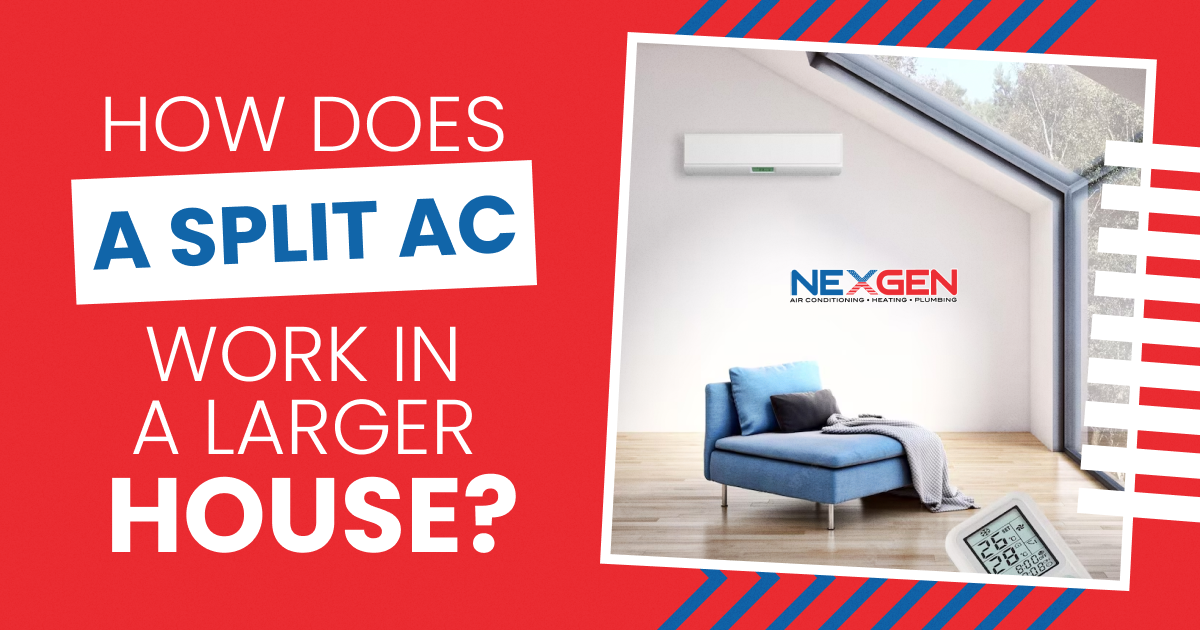How Does a Split AC Work In a Larger House?

NexGen is known for high-quality air conditioning services in Southern California. Our licensed and insured technicians can install any type of system, including a ductless mini-split AC. Mini-split systems are often recommended for smaller homes, older properties, and those where it’s more difficult to install ductwork. Highly versatile and flexible, they can also accommodate a larger home. If you’re wondering, “How does a split AC work for a larger house?”, we’ll look at what you need to consider when setting one up.
How Does a Mini-Split AC Work?
Split ACs, whether single- or multi-zone, have one outdoor compressor/condenser unit. Depending on the system’s type and configuration, the outdoor unit can be connected by refrigerant tubing, a power cable, a condensate drain, and suction tubing to one or more indoor air handlers. Each air handler can be controlled individually, so you can set the temperature as you like for one room or area.
How Many Mini-Splits Do I Need?
You can connect up to eight air handler units to a single condenser unit. But whether this is necessary depends on your home. The system can be expanded with additional units if you decide to build a home addition or convert a basement or attic to a living space.
Whether you need a mini-split for every room depends on your needs. For example, you might like a cooler bedroom while other occupants like it warmer in their bedrooms. Or, you might want the living room warmer and the home office cooler.
As you can see, installing a mini-split AC system requires a lot of planning. But you don’t necessarily need an air handler in every room. This can be expensive in a large home. A single “zone” can include multiple rooms or even an entire floor. It just needs proper airflow to provide sufficient cooling or heating.
Mini-Split AC Size vs. Square Footage
Installing a system that’s the right size is key to how a split AC works in a larger home. A mini-split system’s size is determined by its capacity in British Thermal Units (BTUs). A BTU is a measure of how much energy it uses to remove heat. Here are some examples of room sizes and the capacity required for them:
- 150 to 200 Ft2: 6,000 BTUs
- 300 to 350 Ft2: 8,000 BTUs
- 400 to 500 Ft2: 12,000 BTUs
- 600 to 700 Ft2: 18,000 BTUs
- 1,200 to 1,500 Ft2: 36,000 BTUs¹
Consider Distances
The indoor units and condenser are connected by a conduit, which requires a 3-inch hole in an exterior wall. If you spread a mini-split AC system over multiple rooms and floors, the distance between the farthest head units and the outdoor unit affects how far the refrigerant must travel. The longer this distance, the less efficient the system can be due to friction, the energy required to pump the coolant, and heat transfer between the lines and ambient air (insulating the lines can minimize heat loss).
Depending on the make and model, refrigerant lines can extend 66 to 98 feet from the outdoor unit. This works for most houses. But if you require head units installed at longer distances, or exceed the number of units a condenser can handle, another outdoor unit can be added.
Call NexGen Today
“How does a split AC work in a larger house?” is a question we can easily answer. The experienced technicians at NexGen will explain the process and evaluate the needs of your home. Configuring different zones allows you to set the temperature perfectly for each room. To learn more about ductless heating and cooling systems, schedule a consultation, and learn about options and financing, call 833-729-9735 today.
Source:





















